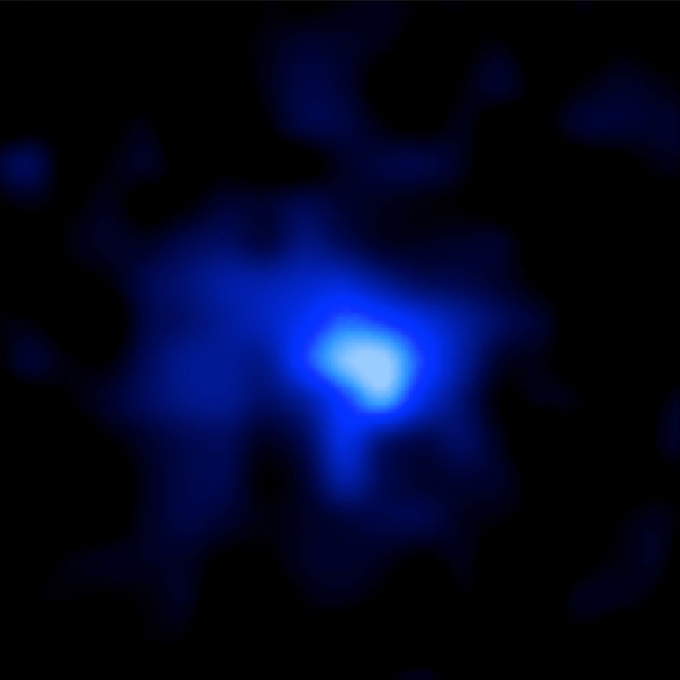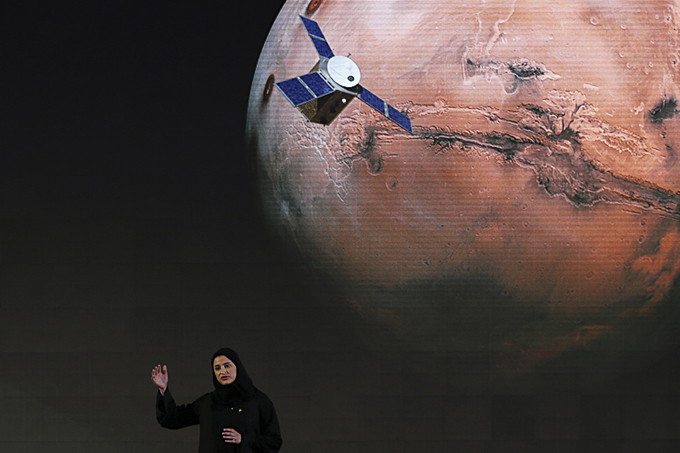News from space

The galaxy, EGS-zs8-1, was originally identified based on its particular colours in images from Hubble and Spitzer and is one of the brightest and most massive objects in the early universe. "It has already grown to more than 15 percent of the mass of our own Milky Way today," said Pascal Oesch, lead author of the study from Yale University, New Haven, Connecticut. "But it had only 670 million years to do so. The universe was still very young then." The new distance measurement also enabled the astronomers to determine that EGS-zs8-1 was still forming stars very rapidly, about 80 times faster than our Milky Way galaxy today (which has a star formation rate of one star per year).
The galaxy, EGS-zs8-1, was originally identified based on its particular colours in images from Hubble and Spitzer and is one of the brightest and most massive objects in the early universe. "It has already grown to more than 15 percent of the mass of our own Milky Way today," said Pascal Oesch, lead author of the study from Yale University, New Haven, Connecticut. "But it had only 670 million years to do so. The universe was still very young then." The new distance measurement also enabled the astronomers to determine that EGS-zs8-1 was still forming stars very rapidly, about 80 times faster than our Milky Way galaxy today (which has a star formation rate of one star per year).

Only a handful of galaxies currently have accurate distances measured in this very early universe. "Every confirmation adds another piece to the puzzle of how the first generations of galaxies formed in the early universe," said Pieter van Dokkum of Yale, second author of the study. "Only the most sensitive telescopes are powerful enough to reach to these large distances." The discovery was only possible thanks to the relatively new Multi-Object Spectrometer For Infra-Red Exploration (MOSFIRE) instrument on the Keck I telescope, which allows astronomers to efficiently study several galaxies at the same time.
Only a handful of galaxies currently have accurate distances measured in this very early universe. "Every confirmation adds another piece to the puzzle of how the first generations of galaxies formed in the early universe," said Pieter van Dokkum of Yale, second author of the study. "Only the most sensitive telescopes are powerful enough to reach to these large distances." The discovery was only possible thanks to the relatively new Multi-Object Spectrometer For Infra-Red Exploration (MOSFIRE) instrument on the Keck I telescope, which allows astronomers to efficiently study several galaxies at the same time.

SpaceX's Dragon capsule launches, Wednesday, May , 2015, from Cape Canaveral, Fla. SpaceX fired the mock-up capsule to test the new, super-streamlined launch escape system for astronauts.
SpaceX's Dragon capsule launches, Wednesday, May , 2015, from Cape Canaveral, Fla. SpaceX fired the mock-up capsule to test the new, super-streamlined launch escape system for astronauts.


This artist's rendering provided by the Johns Hopkins University Applied Physics Laboratory shows the sunshade on the MErcury Surface, Space ENvironment, GEochemistry, and Ranging (Messenger) around the planet Mercury. The sunshade shields the spacecraft's instruments from heat and solar radiation. (Johns Hopkins University Applied Physics Laboratory via AP) Image converted using ifftoany
This artist's rendering provided by the Johns Hopkins University Applied Physics Laboratory shows the sunshade on the MErcury Surface, Space ENvironment, GEochemistry, and Ranging (Messenger) around the planet Mercury. The sunshade shields the spacecraft's instruments from heat and solar radiation. (Johns Hopkins University Applied Physics Laboratory via AP) Image converted using ifftoany

photo provided by NASA shows one of the last images sent by the Messenger spacecraft which is expected to impact the surface of the planet Mercury on Thursday, April , 2015. The largest crater in this image has a diameter of 330 meters (0.2 miles).
photo provided by NASA shows one of the last images sent by the Messenger spacecraft which is expected to impact the surface of the planet Mercury on Thursday, April , 2015. The largest crater in this image has a diameter of 330 meters (0.2 miles).

This photo from a sequence of images provided by NASA, taken from the Dawn spacecraft of Ceres, a dwarf planet located in the asteroid belt between Mars and Jupiter. NASA said the start of science observations was slightly delayed because of a communication glitch. The space agency said the delay won't affect the overall mission.
This photo from a sequence of images provided by NASA, taken from the Dawn spacecraft of Ceres, a dwarf planet located in the asteroid belt between Mars and Jupiter. NASA said the start of science observations was slightly delayed because of a communication glitch. The space agency said the delay won't affect the overall mission.

Sarah Amiri, Deputy Project Manager of a planned United Arab Emirates Mars mission talks about the project named "Hope" - or "al-Amal" in Arabic - which is scheduled be launched in 2020, during a ceremony in Dubai, UAE, Wednesday, May 6, 2015. It would be the Arab world's first space probe to Mars and will take seven to nine months to reach the red planet, arriving in 2021. Emirati scientists hope the unmanned probe will provide a deeper understanding of the Martian atmosphere, and expect it to remain in orbit until at least 2023.
Sarah Amiri, Deputy Project Manager of a planned United Arab Emirates Mars mission talks about the project named "Hope" - or "al-Amal" in Arabic - which is scheduled be launched in 2020, during a ceremony in Dubai, UAE, Wednesday, May 6, 2015. It would be the Arab world's first space probe to Mars and will take seven to nine months to reach the red planet, arriving in 2021. Emirati scientists hope the unmanned probe will provide a deeper understanding of the Martian atmosphere, and expect it to remain in orbit until at least 2023.



